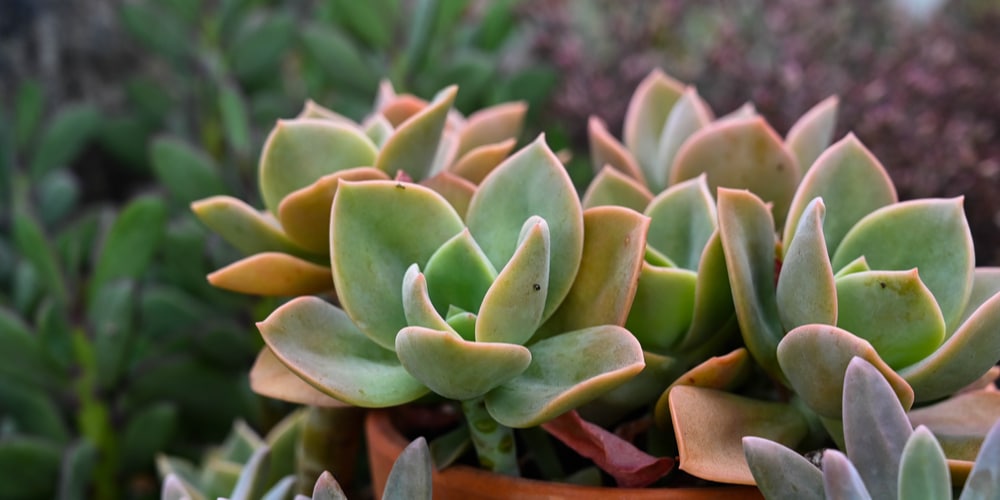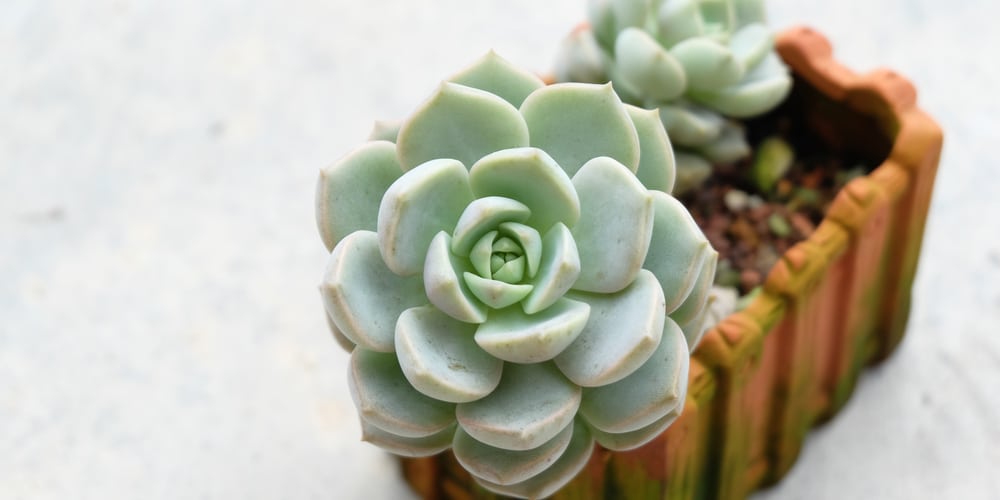Graptoveria Titubans, otherwise known as the Porcelain Plant, has fascinating spoon-shaped blue-gray leaves and tips that change color depending on the temperature.
| Botanical Name | Graptoveria ‘Titubans’ |
| Common Name | Porcelain Plant |
| Plant Type | Perennial |
| Flower Color | Yellow flowers with red dots atop stalks |
| Size When Mature | 8 inches |
| Bloom Time | Spring |
| Sun Requirements | Full sun to partial shade |
| USDA Hardiness Zones | 10 and 11 |
| Soil PH Range | 5.0 to 7.0 |
| Soil Type | Loose and well-drained |
| Water Needs | Low |
| Native Area | Mexico and Colombia |
What you Need to Know About Graptoveria Titubans
The Graptoveria Titubans is a cross between Echeveria derenbergii and Graptopetalum paraguayense. The succulent has short and stubby spoon-shaped leaves that appear matte pastel green, with underlying tones of pink that are more pronounced when temperatures cool down.
Porcelain Plant is an easy-care graptoveria that can grow in a range of different soil and light conditions. It’s proven to be a popular houseplant across the US due to its small size and interesting foliage. Sometimes the plant sends up stalks that terminate in a star-shaped yellow flower with red speckles from spring to summer.
How to Care for Graptoveria Titubans
Here’s everything you need to know about growing and caring for a thriving Graptoveria Titubans
Light
Porcelain Plant is a versatile succulent species that can grow in full sun or partial shade. The reason why it’s a popular houseplant is that Titubans can thrive on a bright windowsill and it wouldn’t make a fuss at all. Rotating to get even growth is not required as long as your Graptoveria Titubans plant is getting enough light on a daily basis.
Too much sun can scorch the leaves, so it’s best to place your Titubans in partial sun or partial shade. There’s no significant difference in terms of growth or health when you grow your Titubans outside or inside the house.
Water and Soil Needs
Another reason why succulents such as the Graptoveria Titubans are beloved is that they’ve adapted to grow in any kind of soil. A medium that’s loose and well-draining, such as a succulent or cactus mix is the perfect soil for your ‘Titubans’ plant to live in. You’ll also need to make sure the container has adequate drainage holes so excess water can go out.
Despite its fleshy appearance, Graptoveria Titubans is very drought tolerant and can survive hot summer days in tropical zones. That said, you should water more when your succulent is situated in partial sun and less when it’s sitting in the shade or by the window. Do not water subsequently- wait a week or two before giving the Porcelain Plant a drink to prevent root rot and fungi-related diseases.
Temperature Requirements
The Porcelain Plant likes warmer zones and prefers to live in zones 10 and 11. However, the succulent can still live and decorate your interior space as a houseplant as long as you keep the plant away from frost and cold drafts.
Fertilizer
The best fertilizer to use on a Graptoveria Titubans is a specially formulated succulent fertilizer applied at half strength.
The best time to feed your Porcelain Plant is during its growing season. Follow the instructions as per the manufacturer, but make it only half-dose, for example, instead of a teaspoon in a liter of water make it only half a teaspoon in one liter. A once-a-year feeding should suffice as long as the plant gets enough sunlight.
Common Diseases
Graptoveria Titubans are subject to common pests such as aphids and spider mites, but it can be remedied easily with a strong jet of water or manually removing them from the leaves.
It’s worth noting that Porcelain Plants can get root rot quickly and when you overwater them. To avoid this problem, make sure that you water only when the soil is completely dry. You can use a wooden chopstick to check moisture levels. Also, plant your Titubans in a container that has adequate drainage holes.
Graptoveria Titubans Propagation
You can easily multiply your Porcelain Plant with leaf propagation, cuttings, or seeds, although seeds are not recommended because they take the longest time.
Any leaf that falls out of the parent plant can be turned into a new Graptoveria Titubans. To get the best chance of success, pick a healthy-looking specimen off the plant and allow the end to dry out in a couple of days. Then, press the fleshy end into a free-draining succulent mix and spray with water every two to three days.
For Titubans plants that have a significant amount of stem, you can cut the section off using sharp and clean scissors or garden shears, then allow the end to dry for a day or so. Stick the stem in a moist and freely-draining medium and water every week or so.


